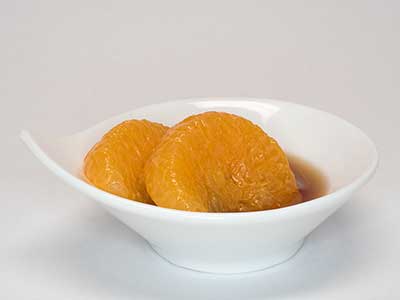May 7, 2012
Intermède

suprêmes de satsuma
(satsuma segments)
All my life I’ve been a collector. I’ve collected menus. I’ve collected matchbooks. I’ve collected English-language Chinese cookbooks. I was once accused of collecting dust. One of my current collections consists of pithy little phrases related to food. One phrase in my thoughts more than the rest is, “Good ingredients, barely touched.” (The phrase comes from the book Heat by Bill Buford, and is said by a cook named Andy who was describing the food at a tapas bar in the Mercat de la Boquería in Barcelona.)
It’s a simple statement, but so very correct. I am fortunate to live in an area where great produce is abundant, high-quality meat is plentiful, and fresh seafood is profuse. In most of my preparations, I strive to live up to those four words and do as little as needed to my fresh ingredients when I transform them into a meal.
Sometimes the concept of doing as little as possible becomes a bit murky. Case in point: The satsumas this year seemed especially good. I decided to enzymatically peel the segments of a couple to see how they would look. Enzymatic peeling is capable of totally removing the albedo from the segments, leaving behind just the juice vesicles. So if I enzymatically peel the segments am I doing as little as possible to the ingredient? At first glance it seems that I making a major change to it, but is the process much different than other peeling methods? Although edible, the albedo doesn’t taste especially good, so its removal seems reasonable. Then again, if I was eating the same fruit on the street, I would only remove the peel, and maybe the well-pronounced stringy portions in the middle of the fruit, before eating each segment with its albedo covering.
Whether I barely touch the satsuma segments or perform major alterations to each one, the result looks neat. Plus they taste much “purer” without their albedo.
1 or 2
satsumas, or similar citrus fruit
Pectinex Ultra SP‑L
cold filtered water
60 ml (1⁄4 c)
vin de noix
finely granulated sugar
1. Carefully peel the fruit, and separate the segments without tearing them. Place them in a bowl. Prepare a solution of Pectinex and water sufficient to cover the segments at the rate of 6 g⁄l (1⁄5 oz⁄qt). Add to the bowl with the segments, and set in the refrigerator.
2. Check the progress of the peeling periodically. It may take up to 24 hours to soften the albedo sufficiently to wash it off under running water. Use a small pair of tweezers to remove any stingy bits that don’t readily wash off.
3. Arrange the cleaned segments in a single layer on a cooling rack in the refrigerator to dry overnight.
4. Reduce the vin de noix to about a tablespoon. Set aside to cool.
5. Place the segments in a small bowl along with the wine and a sprinkling of sugar. Set back in the refrigerator to macerate for as long as another day.
6. To serve, place a couple of the nicest segments in individual serving dishes along with a teaspoon of the liquid.
Yield: 4 servings.
© 2012 Peter Hertzmann. All rights reserved.
